Texture formation of agate in geode
by Taijin Lu and Ichiro SUNAGAWA
www.researchgate.net/publication/250164066_Texture_formation_of_agate_in_geode(a) Uruguay bandThe granular texture of Uruguay bands was first reported by Buch (182,4), and later
investigated in detail by Sunagawa and Ohta (1976). The presence of spherulites in Uruguay
band was reported by Florke et al. (1932). Graetsch et al. ( 1985) reported the total water content
and physical properties of Uruguay bands.
Stratiform horizontal banding (Uruguay band) with granular texture is found only in
some geodes and exclusively occurs at the central bottom of a geode, filling partly the open
space left after the completion of agate bands and CQ (course Quartz). In specimens from some localities, it
was reported that the Uruguay band consists of opal-CT (cristobalite) and not of quartz. But, it was confirmed
that the present samples consist of only quartz.
The stratification is due to the variation of grain sizes of the constituent quartz crystals,
which in general show euhedral forms (Sunagawa and Ohta, 1976). The morphology of these
minute quartz crystals are different from those of ordinary well developed quartz crystals, since
the prism faces are far less developed or almost absent, and major rhombohedral faces develop
much larger than minor rhombohedral faces, leading to a habit close to a rhombohedron, i.e.
trigonal symmetry of quartz structure is better exhibited (Sunagawa and Ohta, 1976). There are
also Uruguay band containing spherulitic aggregates of quartz crystals (Florke et al., 1982).
We therefore selected a sample showing Uruguay bands consisting of both quartz grains and
spherulites for detailed investigation.
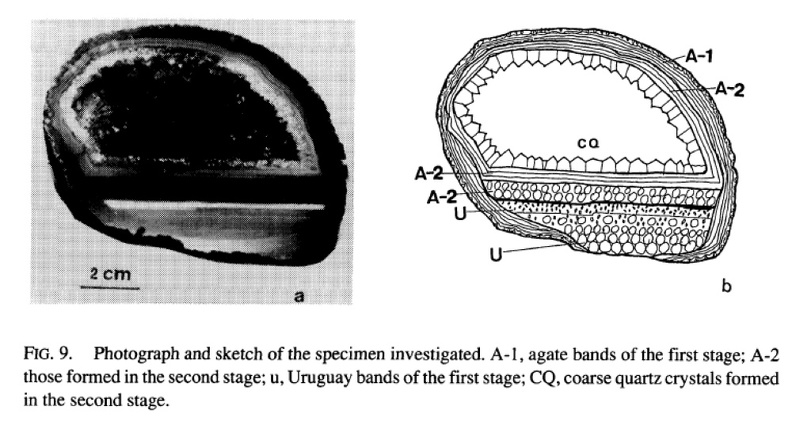
Fig. 9 shows a section of the sample. Although the geode appears to be simply consisting
of one cycle of agate banding, CQ, and Uruguay banding, close investigations indicated that
the geode filling process was completed in two distinctly different stages. This is indicated by
a sketch shown in Fig. 9b. In the first stage, agate banding labeled A-l was formed at first,
followed by the deposition of Uruguay band, labeled U, forming a flat bottomed surface in the
geode.
After completion of this stage, another solution invaded later into this space, and
precipitated agate bands. A-2, and CQ. The agate bands formed on the flat bottom surface take
in appearance a form of horizontal banding,
resembling Uruguay band.
The difference between the real Uruguay band, U, and the apparent horizontal band. A-2, can be seen if careful
observation is made on their textures.
The Uruguay bands formed at the first stage are composed of spherulites only in the
bottom layer and euhedral quartz grains only in the top layer, with an intermediate layer
consisting of both. The proportion of spherulites decreases and that of euhedral quartz grains
increases as going upward. Above the top layer, apparent horizontal band, A2, appears.
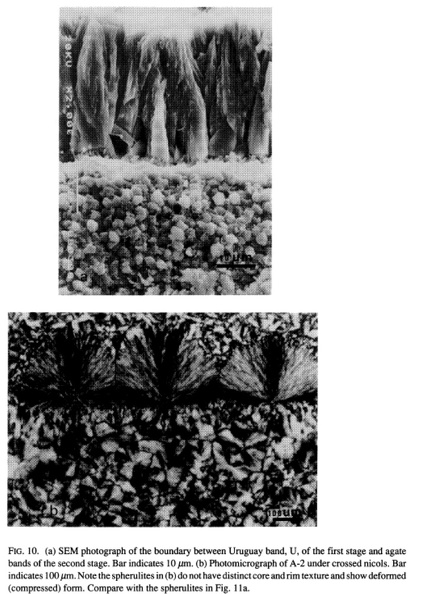
Fig. l0a illustrates clearly a discontinuity and difference between the two types of horizontal layers.
The spherulites in the Uruguay band show core and rim texture. Although spherulites are
also seen in places in the apparent horizontal layer, A-2, their texture, morphology. mode of
occurrence are distinctly different from those of spherulites in the Uruguay band, U. See Fig.
10b. This will be explained later in more details. Semi-spherical or divergent aggregates are
also seen in A2, which continue to the fibrous texture in the agate bands. The observations
indicate that the spherulites in horizontal agate bands of the second stage A-2, and the Uruguay
band. U, are of different origins.
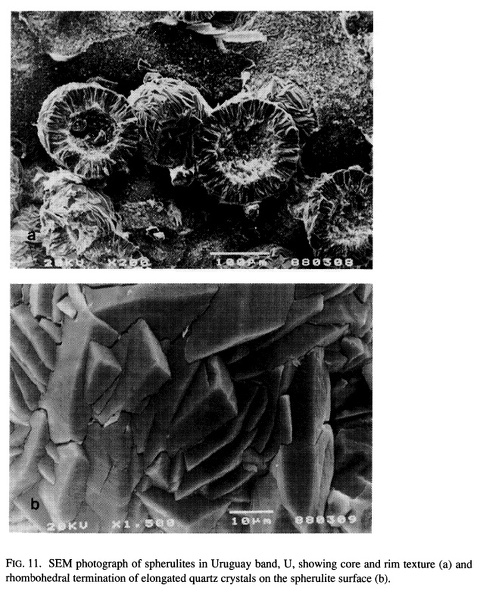 ( b) spherulites
( b) spherulitesFig. 11a, a SEM photograph, shows that the spherulites in the Uruguay band consist of
core and rim portions. The diameter of the core portion and the thickness of the rim are nearly
equal, ca. 50 um. The rim portion is composed of radiating elongated quartz crystals, with
rhombohedral terminations, Fig. llb. From Fig. lla and b, we see that the c-axes of elongated
quartz crystals in the rim are perpendicular to the surfaces of the spherulite and the core.
Namely, they are length-slow type.
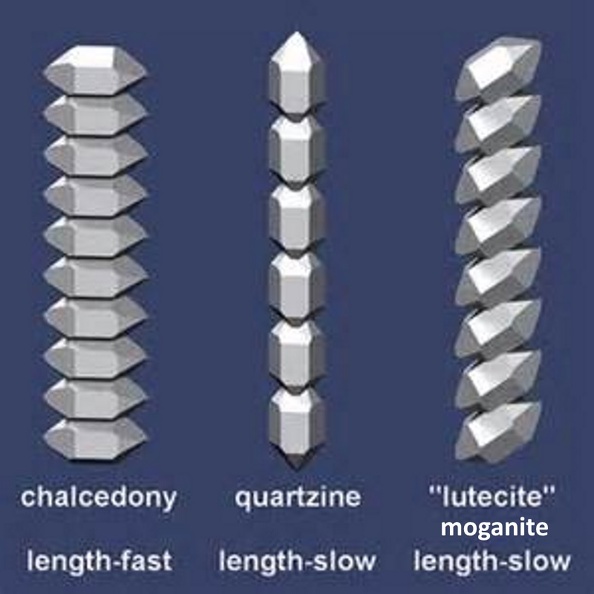
The core portion is more easily etched than the rim portion, indicating losser structure of
the core than the rim. The sizes of spherulites range from few tens µm to 200 µm, and in general
decrease from the bottom to the upper parts of the Uruguay band.
TEM observation of spherulites in the Uruguay band showed that the quartz grains in the
core, 1 to 3 µm across. exhibit euhedral to semi-euhedral morphology and have random
orientations, Fig. 12a. Brazil twin lamellae and dislocations are observed in these grains. In
contrast to this, elongated quartz crystals in the rim portion, Fig. 12b, are composed of fine
quartz crystallites, with sizes ranging from9 to 15 nm in width and more than 100 nm in length,
Fig. l2c. These fine crystallites are single quartz crystals with the c-axes parallel to the
elongation of crystals. The length-slow nature of elongated quartz crystals in the rim portion
of spherulites in Uruguay bands is distinctly different from the length-fast fibers in agate bands.
different from those of the spherulites in Uruguay bands. They are deformed (or compressed)
spherulites, have no distinct core and rim texture, and belong to length-fast type.
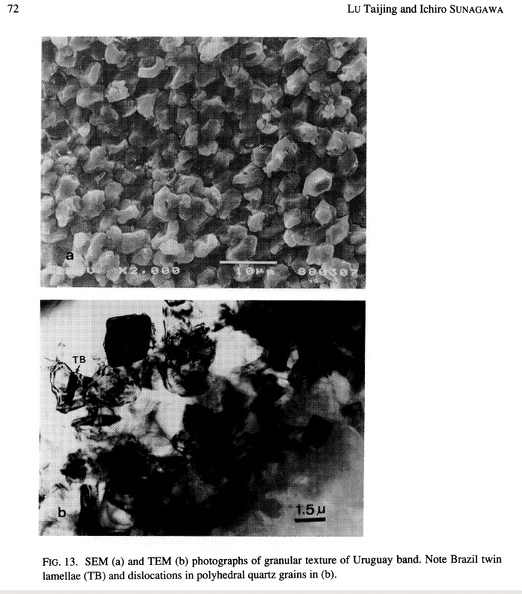 (c) Euhedral quartz grains
(c) Euhedral quartz grainsThe top layer of Uruguay band, U, is entirely composed of only euhedral quartz crystals,
see Fig. 10a and 13a, In the intermediate layer consisting of both spherulites and euhedral
quartz grains, euhedral quartz grains cement the interstitials of spherulites.
The granular quartz crystals are euhedral, and show rhombohedral or stout prismatic
habit, and are around 3 µn across, as seen in Fig. 10a and 13a, SEM photographs. Brazil twin
lamellae and dislocations are observed in these crystals under TEM, Fig. l3b. The morphological characteristics and the sizes of granular quartz are in accordance with the observations
reported by Sunagawa and Ohta (1976).
Summary Important new observations made in the present investigation are as follows:
(1) Optically observable individual fibers of length-fast type in agate bands consist of much
finer fibers with width less than 100 nm, Each fine fiber is composed of numerous quartz
crystallites of less than 100 nm in length, with the c-axes aligning perpendicular to the fiber
elongation.
(2) Uniformly spaced systematic striations, rhythmic extinction banding, and CQ (coarse
quartz crystals and amethyst) show essentially the same texture as that of ordinary agate bands,
in that the textures appear due to systematic repetition of size variations from smaller to larger
components in one band.
(3) As approaching the later stage. a cycle of size variation becomes more uniform and
narrower, and fibrous and divergent textures become less distinct. At the latest stage of
formation of a series of agate banding, coarse quartz crystals develop large, which complete
the cyclic size variations in the formation of agate banding.
(4) Uruguay bands are composed of euhedral quartz grains, or spherulites, or both. The banding
appears due to size variation from large to small components as going apart from the bottom.
This is in opposite to the size variations observed in agate banding.
(5) The spherulites in Uruguay bands show core and rim textures, and the elongated quartz
crystals in the rim portion are of length-slow type, which is different from the length-fast type
of fibers in agate bands.
####################################
My Comment:
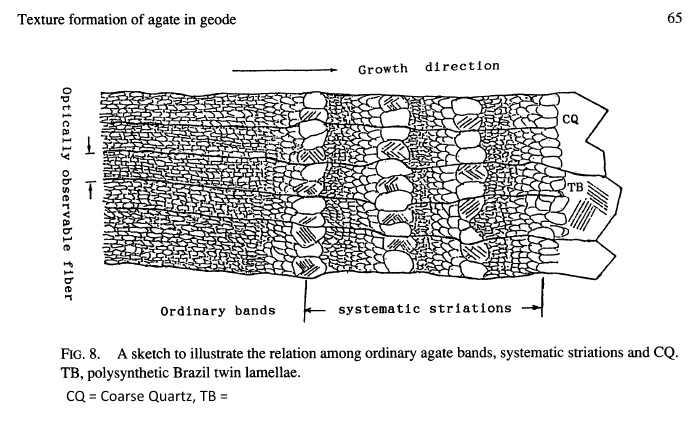
Aughh! I didn't finish! TB = Brazil Twin where goethite inclusions interfered.
Basalt lava flowed 100 feet thick for hundreds of miles. Where it covered wet spots, steam bubbles began to rise through the basalt until frozen in space. The steam cooled to water, creating a vacuum. As the basalt cooled, it shrank and cracked, allowing groundwater to enter the voids.
Comes a heavy rain lasting days - perhaps weeks, stream passes through limestone and Ph goes up. Passes through silica and dissolves it. Ph goes down. Cristobalite-like-fibers form.
Water tumbles into void. Ph goes down even more and silica begins to precipitate. stream passes on and more water enters.

As the thunder clouds roil above, ground currents below flow with them.
SiO
2 fibers begin to attach to iron on walls and ceiling - AND - on iron particles floating in the chamber, forming spheroids, eventually attaching to walls or dropping to the floor.
On walls and floating iron particles, Cristobalite fibers attach, 2nd, Chalcedony begins to grow. 3rd, quartz begins to grow, Stops. Repeat ritual layers until fluid is done. Floors are reverse from walls.
Another rainstorm and it all repeats, but spheroids are different - slow growth instead of fast growth!
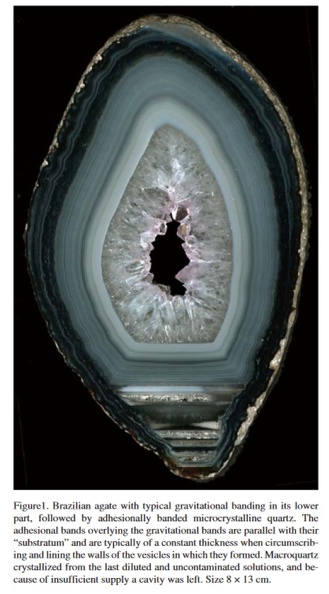


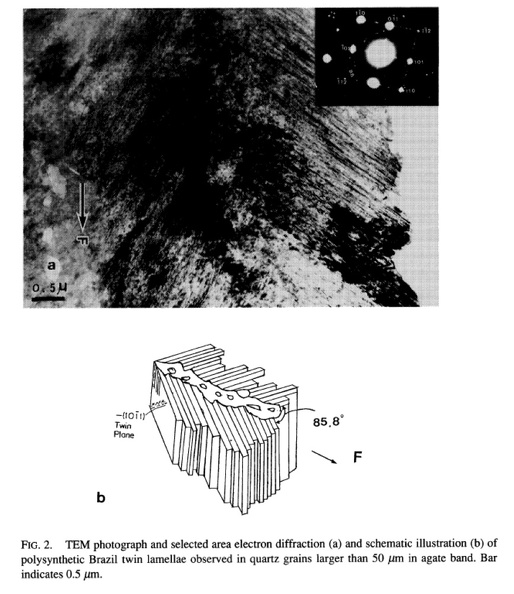

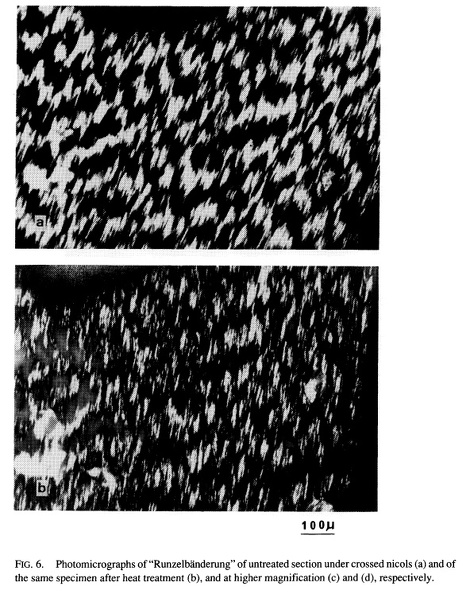




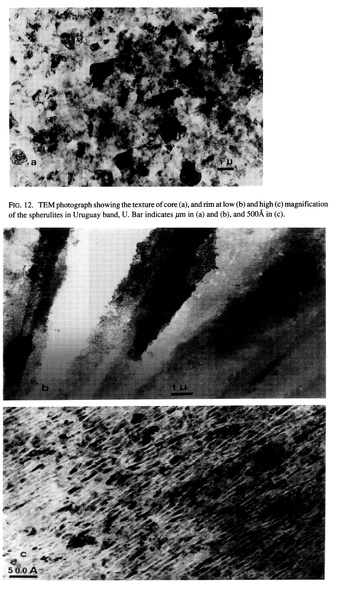

 LOVE this information! Especially Fig 11. How those spheroids sneaked into thundereggs!
LOVE this information! Especially Fig 11. How those spheroids sneaked into thundereggs! 











